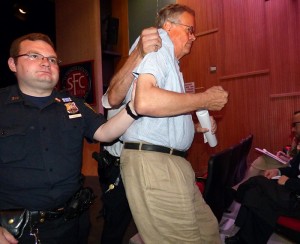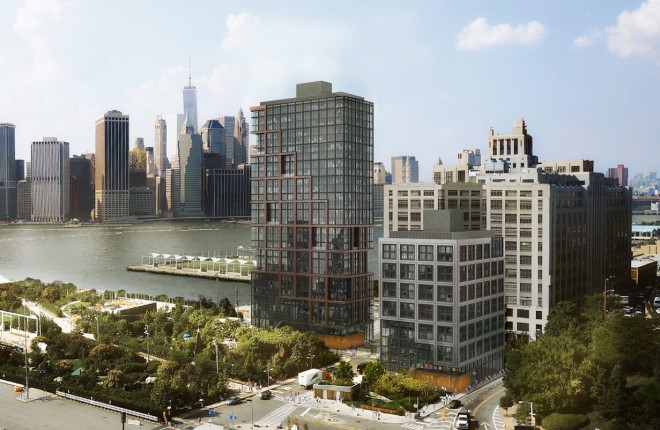A biweekly newsletter with public space news, resources, and opportunities.
A curated dispatch on all things public markets plus the latest announcements from the Market Cities Program.
Standing before an audience of local residents, proponents, and other critics of the controversial Brooklyn Bridge Park Pier 6 redevelopment plan, PPS president Fred Kent began to explain why the Brooklyn Bridge Park Development Corporation (BBPDC) should be stopped from privatizing what should be embraced as a public treasure.

While criticizing the project as an egregious example of using public funds (to the tune of $375M) for private gain, Kent was cut off before the promised six minutes allotted to organizational representatives, and he refused to cede the remainder of his speaking time. Then, despite outraged chants from audience members to “Let him speak!” he was forcibly removed by security and police officers.
But before detailing the disastrous plan for Pier 6 to which Kent and many others are vehemently opposed, we should first acknowledge that there are aspects of the park itself that are indeed worthy of praise.

Brooklyn Bridge Park stretches along roughly 85 acres of prime East River waterfront space along the northern edge of Brooklyn. New Yorkers can visit the park for a number of events or just to relax in one of the borough’s most beautiful spots, which offers spectacular views—maybe even the city’s best—of the Manhattan skyline.
Though its amenities are segmented between different areas, they have nonetheless created thriving zones out of what was once just an open public space, and this is much to the credit of the Brooklyn Bridge Park Conservancy, the organization responsible for the programming of the park. The Conservancy has developed a wide variety of free events and activities that include recitals of the Metropolitan Opera, a summer movie series on the Harbor View Lawn, guided waterfront walks, interactive art installations, fitness classes and sports tournaments, toddler dance parties, a book reading series under the Manhattan Bridge, and many others.
The Brooklyn Bridge Park Conservancy, though, is not to be mistaken for the Brooklyn Bridge Park Development Corporation, which was created for maintenance, construction, and design purposes. Because the BBPDC was mandated in 2005 to be financially self-sustaining, however, it has since received no government funding.
Because of this, BBPDC plans to develop two parcels of land on Pier 6 at the end of Atlantic Avenue, one of Brooklyn’s most important thoroughfares, into two massive residential towers. Many opponents challenge the economic necessity of these developments altogether, since the park's green space is already self-sustaining given the 440 existing (and even more controversial) luxury apartments at One Brooklyn Bridge Park (watch this video footage to see exactly how protected this private development is from the public activity of the park) -- in addition to the nearly 200 other condo units, hotel, and extensive commercial space that is already slated to be built in DUMBO. Rising 29 and 14 stories, the buildings would introduce 339 more condos to the neighborhood. According to plans, they will include both affordable and market rate housing units, as well as ground floor retail establishments.
But the plan has faced many challenges and incited contentious debate surrounding the impact the towers will have on “public” space, the presence of high-end homes (even if in the midst of supposedly “affordable” housing), the quality of the park, and even the environmental impacts of the project.

Fred Kent is a strong voice among many in the coalition of community members and local officials opposing this development. Kent believes that this plan is nothing short of outrageous, and that the economic arguments are simply a way of privately developing what should be public space. Brooklyn Bridge Park already lacks sufficient space that is truly dedicated to public use, and this project sets a dangerous precedent of abandoning or ceding large percentages of our public space to the extremely wealthy in order to get funding for the rest. There is no place for housing in the park, especially if it stands at this important gateway, limiting access to the park.

Brooklyn Bridge Park, in its entirety, should be a place that appeals to all residents and reflects Brooklyn’s uniquely diverse character. Furthermore, not only will these residential developments contribute to congestion in the area, but detractors also worry about the increased pressure they will put on the neighborhood’s already overcrowded public schools. In a letter stating his own opposition to the proposed highrises, State Senator Daniel Squadron explained: “When considered alongside the [nearby Long Island College Hospital] development, PS 8 wait lines, and other rapid changes, all of which are contemplated in isolation, it is impossible to argue that these developments do not have a collective impact on neighborhood character.”
Ultimately, the point that Kent and other advocates for alternative plans to fund the park want to make is that privatized public space is an oxymoron, and that they lack the very qualities that make public spaces exciting places to be in. As recently cited in The Guardian, sociologist Richard Sennett has referred to private public spaces as “dead public spaces” since “the essence of conviviality, spontaneity, encounter and yes, that little sprinkle of chaos, have been stripped out.”
And aside from the aesthetic implications of the plan, Kent argues that there’s something fundamentally dangerous about what the BBPDC is proposing: it gives far too much influence to private developers in taking over public space. What does “public” mean -- as both a value and a right -- if we continue to turn over our shared land to private interests?
“This thing that the BBPDC has planned,” Kent explains, “is not a solution, it’s a golden opportunity to profit off some of New York’s most valuable and valued public spaces.” If the goal of the development is to protect the park, we should rethink the plan. “The fact is,” he continues, “of the world’s great cities--Hong Kong, Copenhagen, Stockholm, Cape Town, Los Angeles, Chicago, London--New York has some of the worst waterfront spaces. Brooklyn Bridge Park has so much potential to change that, so why waste this opportunity on a development that can only make our waterfronts worse?”
Once the park board has given final approval for the plans for Pier 6, construction would start by spring 2016. The completion of the two towers is projected for fall 2017.
The rich text element allows you to create and format headings, paragraphs, blockquotes, images, and video all in one place instead of having to add and format them individually. Just double-click and easily create content.
The rich text element allows you to create and format headings, paragraphs, blockquotes, images, and video all in one place instead of having to add and format them individually. Just double-click and easily create content.
Body Text Body Link
The rich text element allows you to create and format headings, paragraphs, blockquotes, images, and video all in one place instead of having to add and format them individually. Just double-click and easily create content.
Here is some highlighted text from the article.




Headings, paragraphs, blockquotes, figures, images, and figure captions can all be styled after a class is added to the rich text element using the "When inside of" nested selector system.
Headings, paragraphs, blockquotes, figures, images, and figure captions can all be styled after a class is added to the rich text element using the "When inside of" nested selector system.
Headings, paragraphs, blockquotes, figures, images, and figure captions can all be styled after a class is added to the rich text element using the "When inside of" nested selector system.